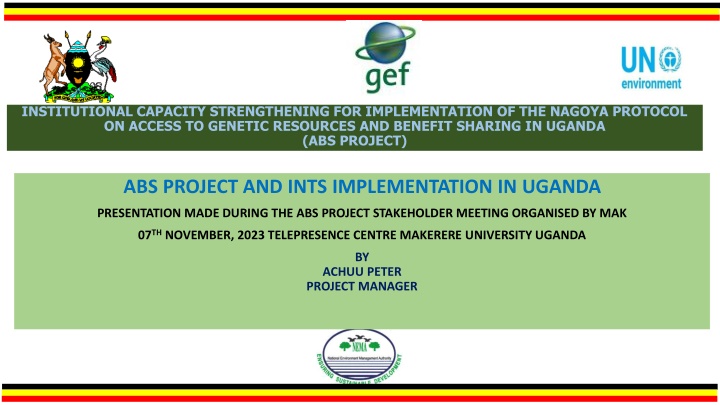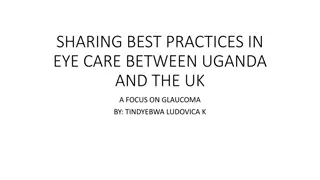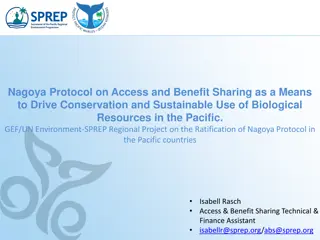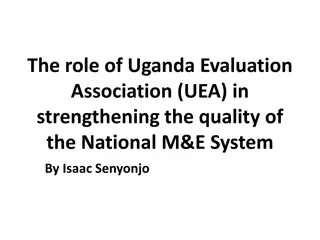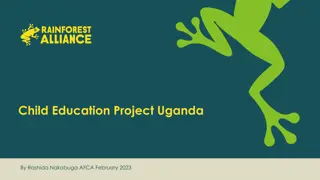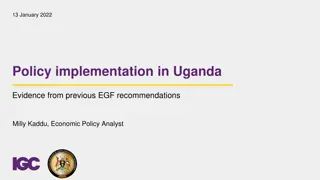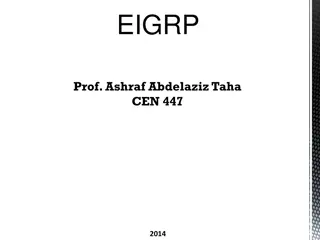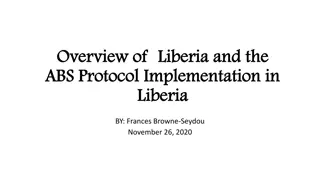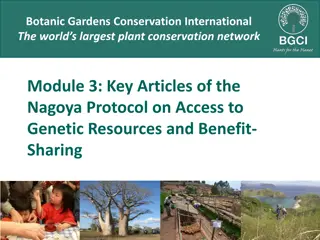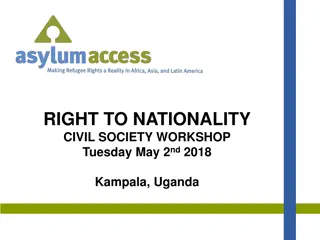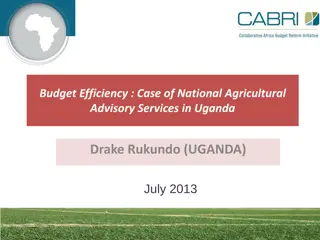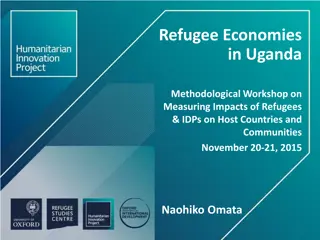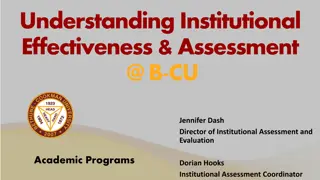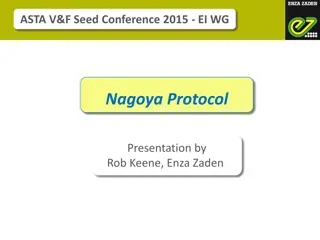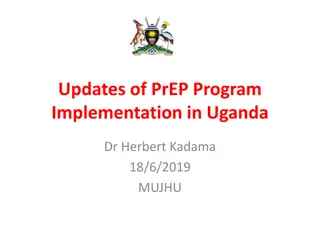Strengthening Institutional Capacity for Nagoya Protocol Implementation in Uganda
Uganda, known for its exceptional biodiversity and diverse indigenous ethnic groups, faces challenges of biodiversity decline and disappearing traditional knowledge associated with genetic resources. The Nagoya Protocol on Access to Genetic Resources and Benefit Sharing (ABS) presents an opportunity to address these issues. However, existing policies and institutional capacities in Uganda need improvement to effectively implement ABS measures.
Download Presentation

Please find below an Image/Link to download the presentation.
The content on the website is provided AS IS for your information and personal use only. It may not be sold, licensed, or shared on other websites without obtaining consent from the author.If you encounter any issues during the download, it is possible that the publisher has removed the file from their server.
You are allowed to download the files provided on this website for personal or commercial use, subject to the condition that they are used lawfully. All files are the property of their respective owners.
The content on the website is provided AS IS for your information and personal use only. It may not be sold, licensed, or shared on other websites without obtaining consent from the author.
E N D
Presentation Transcript
INSTITUTIONAL CAPACITY STRENGTHENING FOR IMPLEMENTATION OF THE NAGOYA PROTOCOL ON ACCESS TO GENETIC RESOURCES AND BENEFIT SHARING IN UGANDA (ABS PROJECT) ABS PROJECT AND INTS IMPLEMENTATION IN UGANDA PRESENTATION MADE DURING THE ABS PROJECT STAKEHOLDER MEETING ORGANISED BY MAK 07TH NOVEMBER, 2023 TELEPRESENCE CENTRE MAKERERE UNIVERSITY UGANDA BY ACHUU PETER PROJECT MANAGER
Uganda The Pearl of Africa Uganda is a country of exceptional biological diversity, resulting from varying landscapes, ranging from glacier-topped mountains, rain forests, savannahs and dry deciduous acacia bush- land to numerous lakes, rivers and wetlands. Uganda has designated many protected areas, including 10 National Parks, 12 Wildlife Reserves, 10 wildlife sanctuaries, 5 community wildlife areas, 506 central forest reserves, 191 local forest reserves and 12 Ramsar Sites. 18,783 species of fauna and flora have been recorded and this places Uganda among the top ten most biodiverse countries in the world. Uganda has a total of 56 major ethnic groups, of which the Batwa, the Karamojong and the Benet are considered indigenous groups. 5/10/2024 2
Traditional Knowledge-TK in Uganda Indigenous groups in Uganda utilize TK in a variety of ways, e.g. production of foods, dyes and medicines. For example the Batwa depend on nature for medicine to treat diseases like pneumonia, backache, malaria and swellings among others. Generally the potential benefits of exploiting and exploring GRs in Uganda for drugs, medicines and food among others are yet to be explored. However TK associated with GRs is disappearing, and some important forms of traditional knowledge such as medicinal uses (e.g. herbs extracted from local plants) are being replaced by modern technology and products 5/10/2024 3
Biodiversity decline Biodiversity is declining rapidly, national, regionally and globally and mainly due to human activities like over-exploitation, pollution, weak enforcement, ecosystem degradation and illegal wildlife trade among others The Nagoya Protocol on Access to Genetic Resources and Benefit Sharing (ABS) has the potential to reduce loss of biodiversity through access and benefit sharing arrangements that promote the conservationand sustainable use of biodiversity. Uganda is a Party to the Nagoya Protocol on ABS was adopted by Parties to the CBD to operationalize the third objective of the CBD. Article 15 of the Convention has provision on ABS. 5/10/2024 4
Baseline/Current situation on ABS in Uganda The existing policies, laws and guidelines do not adequately address ABS issues as well as their coordination and enforcement. The existing institutional and personnel capacity to effectively implement the Nagoya protocol and national ABS regulations is weak. There is lack of management structures and working models at the local government and community levels for implementing national ABS legislation. This is exacerbated by the poor awareness and understanding of ABS There are no clear systems, rules, procedures, roles and responsibilities of different institutions and stakeholders for effective implementation of PIC and MAT during ABS. Existing ABS guidelines are not adequately aligned to the Nagoya Protocol. Currently there is no clear system or mechanism in place to ensure compliance to PIC and MAT. Uganda has no national policy on access to genetic resources 5/10/2024 5
ABS Project Introduction Institutional Capacity Strengthening for Implementation of the Nagoya Protocol on Access to Genetic Resources and Benefit Sharing in Uganda (ABS Project); A four years Government of Uganda Capacity building project; Funded by Global Environment Facility (GEF) through United Nations Environment Programme (UNEP)/executing agency; NEMA and UNCST are the national executing agencies working in collaboration with other state and non-state partners (UWA, NFA, NaFORRI, NCRI, MAK, PGRC, KWCG and UOBDU); The project is of National focus (South Western and North Easter Uganda); ABS Implementation agreement (PCA) was signed in January, 2021
Project Goal and Objective The project goal is to conserve Uganda s genetic resources and associated traditional knowledge and access and share the benefits arising out of their utilization in an equitable and sustainable way; Theproject objective is to strengthen institutional capacity for effective implementation of the Nagoya Protocol and conduct effective awareness campaigns on ABS in Uganda.
Project Components These are basically four including: 1. Component Institutional Framework for ABS; One: Strengthened National Regulatory and 2. Component Two: Capacity building for the implementation of the National ABS; 3. Component Three: Strengthening ABS Management at the Local government and Community Level; 4. Component Four: Information, Education and Awareness on ABS.
Project Outcomes 1. Outcome 1.1 National ABS regulatory and institutional frameworks in compliance with the Nagoya Protocol on ABS in place and operational 2. Outcome 2.1: Government agencies have the skills and competency to implement and enforce compliance to the Nagoya Protocol; 3. Outcome 2.2: Makerere University training and producing professionals with knowledge on ABS; 4. Outcome 2.3: ABS National Focal Point and CNAs effectively carrying out their functions; 5. Outcome 3.1: Effective working models for ABS at the local community level; 6. Outcome 3.2: Effective participation of men and women in benefit sharing; 7. Outcome 4.1: Increased awareness in Uganda on the Nagoya Protocol on ABS To be achieved through delivery of manyoutputs and activities
Project Target Areas, Beneficiaries and Geographical Focus The primary beneficiaries are men, women/citizens of Uganda ; Indigenous Peoples and Local Communities (Karamoja region, South-western and Western regions) specifically the Karimojong and Batwa . Local governments of (Moroto, Nakapiripirit, Napak, Kotido, Abim, Amudat, Kaabong, Kisoro, Kabale, Bun dibugyo, Kanungu and Rubanda) The private sector Government MDAs Among others the benefits include; Trainings Protection especially IPLCs Connections including certification of products Awareness and appreciation Technology and information sharing etc.
Geographical Location of the Seven Protected Areas (CFRs And NPs) for CFM Activities 5/10/2024 11
MAKERERE UNIVERSITY (MAK) In the implementation of ABS project MAK, Will contribute in the attainment of Outcome 2.2: Makerere University training and producing professionals with knowledge on ABS. Review existing curriculum in the Department of Botany; Conduct DACUM (Developing A Curriculum) process and update curriculum content; Implement the curriculum in the department of botany by training students and other stakeholders (scientists, social workers, lawyers, judiciary, prosecutors and police in ABS matters; Train at least 60 professionals (scientists, social workers, lawyers, judiciary, prosecutors and police), imparting knowledge and skills in articulating and negotiating PIC and MAT.
Budget and Timeframe Budget and Timeframe Grant effectiveness Start date: Closing date; 27th January 2021 31st December, 2025 Project Cost $ 11,795,842 Breakdown GEF Support $ 2,560,842 Cash contribution from partners $ 2,100,000 In-kind contribution from partners $ 7,135,000 Total Project Cost 11,795,842 13 10/05/2024
Key Benefits of the ABS Project in addition to Financial support 1. Develop mechanisms for sharing benefits arising from utilization of traditional knowledge on genetic resources. For example, putting in place model contractual clauses and codes of conduct for access to genetic resources, which will enable local people to negotiate and equitably share benefits in extraction of any products within their localities. 2. Working with local communities to develop, test and implement access and benefit sharing arrangements (PIC and MAT) 3. Establish working community structures for negotiating and implementing access and benefit sharing arrangements, partnerships with stakeholders during PIC and MAT. 4. Develop ABS Compliant curriculum for training at University and practitioners; 5. Establish and operationalise Community Forest Management (CFM) for the pilot CFRs, which will constitute the first CFM agreements for the Karamoja region. 6. With Makerere University document TK of the IPLCs of Karimojong and Batwa 7. Assist in the propagation of sandal wood (establishing nurseries for sandal wood raising) 8. Establish online registration and certification system for ABS 9. Create awareness on ABS
IMPLEMENTATION CHALLENGES AND STRATEGIES Challenge Proposed 1. COVID-19 Pandemic and the subsequently lockdowns greatly affected the start of project implementation. 1. Meeting in small numbers while observing SOPs, also virtual meetings shall be prioritized. 2. Delay in the recruitment of staff and start of the project 2. Project staff were recruited to fast tracked activity implementation, initial activities were implement by the Project coordinators.
Project Management Team Project Management Team NAME POSITION Francis Ogwal Project Coordinator (CBD-ABS NFP NEMA) Innocent Akampurira Project Coordinator (ABS NFP UNCST) Achuu Simon Peter Project Manager (NEMA) Tusiime Adam Project Officer (Kisoro) James Osiru Project Officer (Karamoja) Daniel Abowe Project Support Officer (UNCST) Aminah Nakachwa (Ag) Project Finance Officer (NEMA) Gerald Jakwonga Driver (NEMA)
END Thank You for Listening
